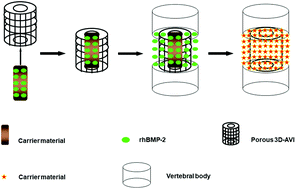当前位置:
X-MOL 学术
›
Biomater. Sci.
›
论文详情
Our official English website, www.x-mol.net, welcomes your
feedback! (Note: you will need to create a separate account there.)
Improved osseointegration with rhBMP-2 intraoperatively loaded in a specifically designed 3D-printed porous Ti6Al4V vertebral implant.
Biomaterials Science ( IF 5.8 ) Pub Date : 2019-12-23 , DOI: 10.1039/c9bm01655d Teng Zhang 1 , Qingguang Wei , Daoyang Fan , Xiaoguang Liu , Weishi Li , Chunli Song , Yun Tian , Hong Cai , Yufeng Zheng , Zhongjun Liu
Biomaterials Science ( IF 5.8 ) Pub Date : 2019-12-23 , DOI: 10.1039/c9bm01655d Teng Zhang 1 , Qingguang Wei , Daoyang Fan , Xiaoguang Liu , Weishi Li , Chunli Song , Yun Tian , Hong Cai , Yufeng Zheng , Zhongjun Liu
Affiliation

|
Three-dimensional (3D)-printed porous Ti6Al4V implants are commonly used for reconstructing bone defects in the treatment of orthopaedic diseases owing to their excellent osteoconduction. However, to achieve improved therapeutic outcomes, the osteoinduction of these implants requires further improvement. The aim of this study was to investigate the combined use of recombinant human BMP-2 (rhBMP-2) with a 3D-printed artificial vertebral implant (3D-AVI) to improve the osteoinduction. Eight male Small Tail Han sheep underwent cervical corpectomy, and 3D-AVIs with or without loaded rhBMP-2 in cavities designed at the center were implanted to treat the cervical defect. Radiographic, micro-computed tomography, fluorescence labelling, and histological examination revealed that the osseointegration efficiency of the rhBMP-2 group was significantly higher than that of the blank control group. The biomechanical test results suggested that rhBMP-2 reduced the range of motion of the cervical spine and provided a more stable implant. Fluorescence observations revealed that the bone tissue grew from the periphery to the center of the 3D-AVIs, first growing into the pore space and then interlocking with the Ti6Al4V implant surface. Therefore, we successfully improved osseointegration of the 3D-AVI by loading rhBMP-2 into the cavity designed at the center of the Ti6Al4V implant, realizing earlier and more stable fixation of implants postoperatively in a simple manner. These benefits of rhBMP-2 are expected to expand the application range and reliability of 3D-printed porous Ti6Al4V implants and improve their therapeutic efficacy.
中文翻译:

与rhBMP-2改善的骨整合,在术中装入专门设计的3D打印的多孔Ti6Al4V椎骨植入物中。
三维(3D)打印的多孔Ti6Al4V植入物由于其出色的骨传导性,通常用于修复骨科疾病的骨缺损。然而,为了获得改善的治疗效果,这些植入物的骨诱导需要进一步的改善。这项研究的目的是研究重组人BMP-2(rhBMP-2)与3D打印的人工椎骨植入物(3D-AVI)的组合使用,以改善骨诱导。对八只雄性小尾寒羊进行了颈椎切除术,并在中心设计的腔中植入了带有或不带有rhBMP-2的3D-AVI,以治疗宫颈缺损。射线照相,微型计算机断层扫描,荧光标记,组织学检查显示,rhBMP-2组的骨整合效率明显高于空白对照组。生物力学测试结果表明,rhBMP-2减少了颈椎的活动范围,并提供了更稳定的植入物。荧光观察表明,骨组织从3D-AVI的外围生长到中心,首先生长到孔隙空间中,然后与Ti6Al4V植入物表面互锁。因此,我们通过将rhBMP-2加载到Ti6Al4V植入物中心设计的腔中,成功地改善了3D-AVI的骨整合,以简单的方式实现了术后早期和更稳定的植入物固定。
更新日期:2020-03-03
中文翻译:

与rhBMP-2改善的骨整合,在术中装入专门设计的3D打印的多孔Ti6Al4V椎骨植入物中。
三维(3D)打印的多孔Ti6Al4V植入物由于其出色的骨传导性,通常用于修复骨科疾病的骨缺损。然而,为了获得改善的治疗效果,这些植入物的骨诱导需要进一步的改善。这项研究的目的是研究重组人BMP-2(rhBMP-2)与3D打印的人工椎骨植入物(3D-AVI)的组合使用,以改善骨诱导。对八只雄性小尾寒羊进行了颈椎切除术,并在中心设计的腔中植入了带有或不带有rhBMP-2的3D-AVI,以治疗宫颈缺损。射线照相,微型计算机断层扫描,荧光标记,组织学检查显示,rhBMP-2组的骨整合效率明显高于空白对照组。生物力学测试结果表明,rhBMP-2减少了颈椎的活动范围,并提供了更稳定的植入物。荧光观察表明,骨组织从3D-AVI的外围生长到中心,首先生长到孔隙空间中,然后与Ti6Al4V植入物表面互锁。因此,我们通过将rhBMP-2加载到Ti6Al4V植入物中心设计的腔中,成功地改善了3D-AVI的骨整合,以简单的方式实现了术后早期和更稳定的植入物固定。











































 京公网安备 11010802027423号
京公网安备 11010802027423号